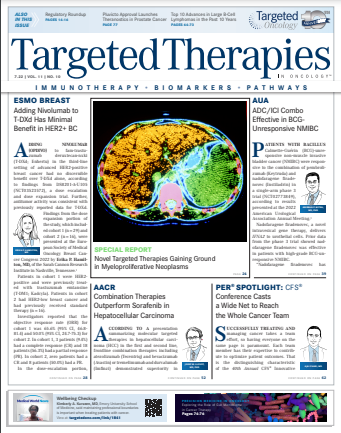Exploring Emerging IO Combinations in Hepatocellular Carcinoma
A presentation by Richard S. Finn, MD, during the American Association for Cancer Research Special Conference, focused on phase 3 combination studies in that setting.
Richard S. Finn, MD

A number of trials are exploring immune-oncology (IO) therapies in combination with VEGF antibodies, tyrosine kinase inhibitors (TKIs), and other IO agents as potential new strategies for patients with hepatocellular carcinoma. A presentation by Richard S. Finn, MD, during the American Association for Cancer Research Special Conference, focused on phase 3 combination studies in that setting.1
IO + VEGF Antibodies
Current standard combinations include bevacizumab (Avastin), the antiangiogenic agent that displays additional immunomodulatory effects, normalizes tumor vasculature, which leads to an increase in T-cell infiltration, and IO treatments.2 When combined with the immune checkpoint inhibitor (ICI) atezolizumab (Tecentriq), bevacizumab may enhance the ICI’s efficacy by reversing VEGFmediated immunosuppression to promote T-cell infiltration into the tumor. Findings from trial GO30140 (NCT02715531),3 which looked at dual blockade of PD-L1 and VEGF, demonstrated a confirmed objective response of 36% (n = 37/104; 95% CI, 26-46), after a median follow-up of 12.4 months.
“That [finding] caught our attention because that was more than twice what we saw with singleagent IO,” said Finn, a professor of medicine at the David Geffen School of Medicine at UCLA. “And this was the basis for the IMbrave150 study, which was a large global study in patients with frontline liver cancer, with coprimary end points of overall survival [OS] and progression-free survival [PFS].”
In IMbrave150 (NCT03434379), patients were randomized 2:1 to receive 1200 mg of atezolizumab once every 3 weeks and 15 mg/kg bevacizumab once every 3 weeks compared with 400 mg of sorafenib (Nexavar). The primary analysis of OS and PFS revealed a hazard ratio (HR) of 0.58 and 0.59, respectively, after a median followup of 8.6 months.4
With longer follow-up, OS has been reported at 19.2 months (95% CI, 17.5-23.7). “For future trials, we’re going to have to ask, ‘How are we going to improve on 19 months?’ ” Finn asked. “The bar [for this combination] has been set pretty high.” However, for patients who do not respond favorably, it is an opportunity for clinical development, Finn added.
IO + TKI
The phase 3 COSMIC-312 trial (NCT03755791) evaluated cabozantinib (Cabometyx) with or without atezolizumab vs sorafenib in patients with advanced HCC. Patients were randomized to receive 40 mg cabozantinib and 1200 mg atezolizumab every 3 weeks (n = 394) vs 400 mg of sorafenib (n = 192) vs 60 mg of cabozantinib (n = 64). The trial’s primary end points were OS and PFS.
Finn said the trial met its primary end point of PFS at final analysis. Patients in
the treatment arm had a median PFS of 6.8 months (99% CI, 5.6-8.3) vs 4.2 months (99% CI, 2.8-7.0) for the control arm (HR, 0.63; 99% CI, 0.44-0.91; P = .0012). Median OS in the treatment arm was 15.4 months (96% CI, 13.7-17.7) vs 15.5 months (96% CI, 12.1-not evaluable [NE]; HR, 0.90 [96% CI, 0.69-1.18]; P = .438).5
The combination demonstrated an objective response rate (ORR) of 11% (95% CI, 8.1%-14%) vs 3.7% (95% CI, 1.6%-7.1%) for the control arm.
“That’s less than single-agent IO,” Finn noted. “It’s the totality of the data that makes it a challenge.”
Single-arm KEYNOTE-524 (NCT03006926) evaluated lenvatinib (Lenvima) and pembrolizumab (Keytruda) and investigators reported an ORR of 36% (95% CI, 26.6%- 46.2%), with 1 complete response and 35 partial responses.6
Median duration of response (DOR) for confirmed responders was 12.6 months (95% CI, 6.9-NE) with a disease control rate of 88% (95% CI, 80.0%-93.6%).6
The phase 2 RESCUE trial (NCT03463876)7 evaluated camrelizumab in combination with apatinib in patients with advanced HCC. Investigators reported an ORR of 34% (95% CI, 23%-47%), a median DOR of 14.8 months (95% CI, 5.5-not reached [NR]), and a median PFS of 5.7 months (95% CI, 5.4-7.4). In the second line (n = 120), ORR was 23% (95% CI, 15%-31%), median DOR was not reached, and the median PFS was 5.5 months (95% CI, 3.7-5.6).
IO + IO
CheckMate 040 (NCT01658878), evaluated the combination of nivolumab and ipilimumab (Yervoy) in patients with HCC.8 Patients were randomized 1:1:1 to either nivolumab 1 mg/kg plus ipilimumab 3 mg/kg, administered every 3 weeks (4 doses), followed by nivolumab 240 mg every 2 weeks (arm A); nivolumab 3 mg/kg plus ipilimumab 1 mg/kg, administered every 3 weeks (4 doses), followed by nivolumab 240 mg every 2 weeks (arm B); or nivolumab 3 mg/kg every 2 weeks plus ipilimumab 1 mg/kg every 6 weeks (arm C).
“This combination is approved in the second line with an accelerated approval,” Finn said. “We’re waiting for the results from the confirmatory study.”
Median OS for arm A was 22.8 months, arm B was 12.5 months, and arm C was 12.7 months.
“All 3 arms demonstrated similar response rates in the second-line population, but when OS was evaluated arm A had a provocative [OS] of 23 months and this was submitted to the FDA review,” Finn said.8
The HIMALAYA trial (NCT03298451) evaluated a single priming dose of tremelimumab plus durvalumab (T300 + D; Imfinzi) vs durvalumab vs sorafenib. The trial was stratified by etiology. In the D300 + D arm, median OS was 16.4 months (95% CI, 14.2- 19.6) vs a median OS of 13.8 months (95% CI, 12.3-16.1; HR, 0.78 [96.02% CI, 0.65- 0.92]; P = .0035).
Looking Ahead
Future combinations will focus on standard-of-care regimens plus new agents, Finn said.
These studies will be population driven with a focus on biomarker identification and clinical characteristics. He expects these studies to be hypotheses driven with the strategy to overcome both de novo and acquired resistance. Identifying new targets for HCC will continue to drive clinical trials.
“In the near future, we await the results of other frontline studies to establish other options for patients, including TKI + IO combinations and IO-IO combinations,” Finn said.
“Keep in mind, these newer combinations will need to beat the 19.2 months associated with atezolizumab/bevacizumab.”
REFERENCES:
1. Finn RS. Combination therapies including checkpoint inhibitors in HCC: the dawn of a new era. Presented at: AACR Special Conference: Advances in the Pathogenesis and Molecular Therapies of Liver Cancer; May 5-8, 2022; Boston, MA. Plenary session #6. https://bit.ly/3O9CAoC
2. Hegde PS, Wallin JJ, Mancao C. Predictive markers of anti-VEGF and emerging role of angiogenesis inhibitors as immunotherapeutics. Semin Cancer Biol. 2018;52(Pt 2):117-124. doi:10.1016/j.semcancer.2017.12.002
3. Lee MS, Ryoo BY, Hsu CH, et al; GO30140 investigators. Atezolizumab with or without bevacizumab in unresectable hepatocellular carcinoma (GO30140): an open-label, multicentre, phase 1b study. Lancet Oncol. 2020;21(6):808-820. doi:10.1016/S1470-2045(20)30156-X
4. Finn RS, Qin S, Ikeda M, et al; IMbrave150 investigators. Atezolizumab plus bevacizumab in unresectable hepatocellular carcinoma. N Engl J Med. 2020;382(20):1894-1905. doi:10.1056/NEJMoa1915745
5. Kelley RK, Yau T, Cheng AL, et al. Cabozantinib (C) plus atezolizumab (A) versus sorafenib (S) as first-line systemic treatment for advanced hepatocellular carcinoma (aHCC): Results from the randomized phase III COSMIC-312 trial. Ann Oncol. 2022;33(1):114-116. doi:10.1016/j.annonc.2021.10.008
6. Finn RS, Ikeda M, Zhu AX, et al. Phase Ib study of lenvatinib plus pembrolizumab in patients with unresectable hepatocellular carcinoma. J Clin Oncol. 2020;38(26):2960-2970. doi:10.1200/JCO.20.00808
7. Xu J, Shen J, Gu S, et al. Camrelizumab (C) in combination with apatinib (A) in patients with advanced hepatocellular carcinoma (RESCUE): an open-label, multi-center, phase II trial. Ann Oncol. 2020;31(suppl 4):S689. doi: 10.1016/j.annonc.2020.08.1099
8. Yau T, Kang YK, Kim TY, et al. Efficacy and safety of nivolumab plus ipilimumab in patients with advanced hepatocellular carcinoma previously treated with sorafenib: the CheckMate 040 randomized clinical trial. JAMA Oncol. 2020;6(11):e204564. doi:10.1001/jamaoncol.2020.4564

Survivorship Care Promotes Evidence-Based Approaches for Quality of Life and Beyond
March 21st 2025Frank J. Penedo, PhD, explains the challenges of survivorship care for patients with cancer and how he implements programs to support patients’ emotional, physical, and practical needs.
Read More